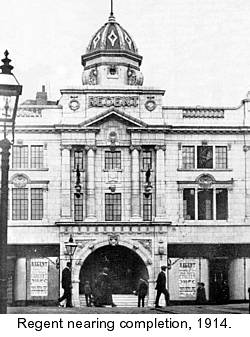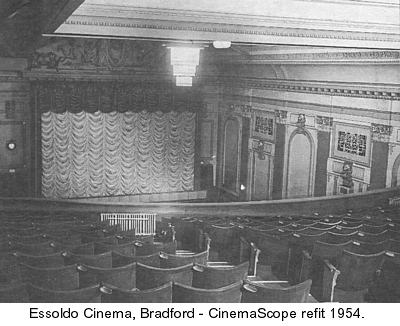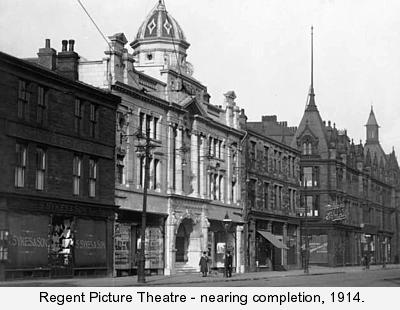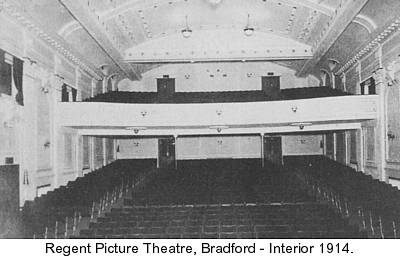|
Regent / Essoldo Cinema Manningham Lane, Bradford.

Location A purpose-built brick building to the design of local architect H.W Rogerson MSA of Cheapside. Work commenced early in 1914 to build this theatre/cinema sandwiched between older shop and office properties. Located on the (even then) busy west side of Manningham Lane between Fountain Street and Drewton Street; the latter both lined with terraced houses. Enter Will Phillips Will Phillips had another motive for setting up this business as he was also managing director and prime mover of the company behind the new Regent project and the importance of Phillips and his Imperial Film Company will be seen later in the Regent's history. It was 1st September 1913 that the new company was registered as Regent Picture House (Bradford) Ltd with £20,000 in £1 shares. Building Exterior Either side of the central section, the white terracotta frontage continued over shop units and upwards two floors to an ornate balustrade at roof level. The first and second floor windows each carried additional ornate decoration. The central entrance was a large highly ornate rectangular structure into which a half-moon entrance led up five white marble steps to the central paybox with heavy oak and glass double doors either side. Ornate Interior The stepped balcony (circle) with parquette floor and carpeted aisles offered perfect sight lines to the stage and screen. (However, this balcony was supported by two round pillars which interrupted sight lines in the rear stalls.) The Winter Garden on the balcony floor included a Tea Room, Gentlemen's Smoke Room, writing and retiring rooms and cloak rooms. A feature was its artistic decoration with wooden trellis work, flowers, climbing vines and handsome electroliers (pendant light fittings) and all with hot water heating radiators - all quite a luxury for 1914. The rectangular projection room at 15 feet wide and 10 feet deep was built out into the circle foyer. The projection room was split into two levels with rewind and storage rooms at circle foyer level and projection room above. Equipment consisted of two projectors and later the RCA sound system. The Auditorium The stalls had a raked (sloping) floor with seating in both stalls and circle in three blocks across the width with two aisles and a cross-over aisle spanning two side exit doors. Seating capacity was 1377. The seating throughout was upholstered in dark blue velvet and matching Wilton carpet to contrast with the decorations of white and gold. The Regent was equipped from the start with a stage 35 feet wide and 30 feet deep and two dressing rooms and orchestra pit. The rectangular proscenium with an opening 30 feet wide was topped by splendid plaster figures in a 'coat of arms' style design. Civic Opening "A Grand Patriotic Concert"Concert Programme included . . . The Bradford Musical UnionThe Lord Mayor said ". . . another evidence of Bradford enterprise . . . there would be general agreement that in respect of originality of design, splendour of decorative work and variety of comforts afforded, the Regent quite surpassed even what the city already boasted. Such buildings as that had quite transformed the appearance of the city's beauty would be quickened by such novel architecture". Sir William Priestley spoke of the War and he "trusted that when better times came that place (the Regent) would continue to be a real home of culture". Captain Burton moved the vote of thanks. W.E Stevens, the manager of the new cinema had received congratulatory telegrams from the directors, staff and orchestra of the London Hippodrome from which he came to take charge of the new Regent. 
The first film shown to the public on Friday 2nd October 1914 . . . The Sensation of the Picture WorldThe following week Monday 5th October 1914 the public could see . . . Special and Exceptional Programmeand from Thursday 8th October 1914 it was . . . "Isle of Abandoned Hope" - 1914 USA B/W Silent Local News Films 1920's Dances Royal Visit Monday 29th November 1920 at 2.45pm.Artists performing on stage were . . . Nellie Judson - soprano, Margaret Allison - contralto,Tickets for this special matinée were 2/6d, 5/- in the stalls and 10/6d in the royal balcony with proceeds donated to Naval charities. Whitby Norton's 8-piece Grand Orchestra played regularly at the Regent with Norton leading on violin; they were also available for concerts, receptions and dances. (Norton was also in charge of the Bradford Symphony Orchestra before being disbanded in 1925.) Following the Matinée, the Duke of York along with civic dignitaries and Phillips' fellow directors (including Robert Richardson of West Bradford Picture Theatres) retired to the Regent Café for afternoon tea and speeches during which Will Phillips presented the Duke with two glass lantern slides taken some years earlier showing the Duke as a Midshipman. In the evening the Duke and his entourage then visited the Alhambra Theatre. Change to Theatre New Owners "Coinciding with monthly faith-healing services at a Bradford church . . .  A new name had come to Bradford from Huddersfield in 1925 - a former tailor, Mark Freedman, who on taking over the Regent reinstated films only and he later leased the cinema to Regent Circuit Ltd part of the growing national ABC Circuit (and incorporating the Savoy Cinemas circuit).
A new name had come to Bradford from Huddersfield in 1925 - a former tailor, Mark Freedman, who on taking over the Regent reinstated films only and he later leased the cinema to Regent Circuit Ltd part of the growing national ABC Circuit (and incorporating the Savoy Cinemas circuit).In 1929 the RCA Sound System was installed and the films shown at the Regent were run in conjunction with the ABC controlled Savoy in Darley Street. Resident manager was now J.H.Royston. By the mid-1930s it called itself Regent Theatre in KYB records. By December 1938 the Regent had another new owner in the form of Manchester based Emery Cinema Circuit Ltd and was advertised as being "An Emery Theatre" which meant very little to local people. Meanwhile the cinema had steadily gone downhill and become second rate by comparison with other and newer city centre cinemas. During a three week closure Emery redecorated the cinema and boasted the installation Western Electric's Mirrophonic Sound System - more details on the Mirrophonic system can be found on the Empire cinema page where it had been installed the previous year. Seating capacity was now listed as 1384 in KYB. J.F. Emery hailed from Salford where he started his cinema business in 1919. He was a councillor, alderman and in 1932-33 Mayor of Salford and became MP for Salford West. By 1950 his Emery Circuit comprised over 30 cinemas scattered across the country. Emery re-opened the Regent on Monday 26th December 1938 with . . . A Grand Re-opening Attraction Essoldo to the Rescue Essoldo added a huge vertical illuminated fin-like name sign above the canopy and rising to the top of the building and completely out of character with everything else around. By this time it was looking rather seedy and neglected with an auditorium smelling of Jeyes Fluid sprayed regularly "For Your Comfort" said the screen advert. At some point (date unknown) the octagonal tower, dome and flagpole had been removed. Refurbishment and CinemaScope 
The most significant alteration was the installation of CinemaScope with full stereophonic sound, ie. 3 channels (left, centre, right) from the screen plus an 'ambient' channel with speakers around the auditorium to the required specification of 20th Century Fox the film producers. The Essoldo was the third city centre cinema (after the Gaumont and Odeon) to install CinemaScope but the only one to have the full ambient surround stereo system. The ageing Simplex projectors and Peerless arc were now fitted with costly anamorphic lenses and magnetic sound heads. The new screen was built out in front of the proscenium opening and was fronted by a festoon curtain which rose and fell across the wide screen. The new screen with its motorized masking was used to good and professional effect for when the curtain rose on CinemaScope films during their famous 20th Century Fox Fanfare (by Alfred Newman) intro, the side masking would slowly open to its full width thus enhancing the visual experience of this new widescreen wonder - a tidy bit of good showmanship. The luxurious new Essoldo reopened on Monday 7th June 1954 with . . . "Flight of the White Heron" - 1954 USA Eastmancolor 96mins.Within days of the film opening, the Bradford Secondary Education Sub-Committee turned down a suggestion that schoolchildren might see the film of the Queen's tour in school time. The manager had made an offer that arrangements could be made to show the film on mornings during its second week. The Committee replied "it is not prepared to make arrangements for pupils to attend in school hours" - not a popular decision! Many 20th Century Fox CinemaScope spectaculars were to follow, some for extended runs as long queues regularly formed outside the cinema - a sight not seen since its early Regent days. 
In August 1957 the police investigated the Great Cigarette Robbery at the Essoldo. A thief had scaled the 7-feet high wall in an exit alleyway in Fountain Street to steel 10,000 cigarettes. The cinema manager, Arnold Fletcher, said "the safe had been moved but no attempt had been made to open it". (Source: T&A 11 Aug 1957.) Provincial Premier At this Theatre, Thursday 5th March 1959 at 11.00pm Origin of the 'Essoldo' Name During the Second World War (1939-45) Sheckman proclaimed "great faith in the future of the cinema" and bought up cheaply cinemas scattered all over the country and formed Essoldo Circuit (Control) Ltd with Sol Sheckman as Chairman operating from offices in Newcastle-upon-Tyne. The southern counties part of the business was controlled by his brother Capt. Mark Sheckman from London offices. Mark Sheckman took control after Sol Scheckman's death in the late1960's. The Essoldo Circuit was very much a family concern and the name Essoldo is made up from the first names of Esther (his wife), Soloman and Dorothy (his daughter). Quite simple really but it has puzzled a lot of people for many years. The End "Duel at Rio Bravo" - 1965 Spain Technicolor A Later Life From 1968 it reopened as an Asian cinema run by the Pakistan National Film Club and Munir Ahmed Khan and was a hit with the Asian community by showing their favourite films plus Indian, Hong Kong and Western epics as well. "My late father, Munir Ahmed Khan, was the last person to run the (former) Essoldo. Fire Disaster The fire brigade prevented the blaze from reaching most of the auditorium but too much of the building had been wrecked. Eventually the building and the surrounding shops were demolished. The new Drewton Road dual carriageway now runs across part of the site. May not be copied or reproduced without permission.
|
 The frontage facing east on Manningham Lane was described as "a handsome elevation in the French Classic style" with white terracotta and a central section with four part-fluted decorated pillars supporting a Greek Ionic capital and architrave and central cyma with the whole topped by an octagonal tower and similarly octagon faced dome with flagpole.
The frontage facing east on Manningham Lane was described as "a handsome elevation in the French Classic style" with white terracotta and a central section with four part-fluted decorated pillars supporting a Greek Ionic capital and architrave and central cyma with the whole topped by an octagonal tower and similarly octagon faced dome with flagpole. A long rectangular hall approximately 60 feet wide and 110 feet long with a vaulted ceiling in two levels and a curved fronted balcony. The side walls relieved with ornate pilasters and decorative panels.
A long rectangular hall approximately 60 feet wide and 110 feet long with a vaulted ceiling in two levels and a curved fronted balcony. The side walls relieved with ornate pilasters and decorative panels. At last in 1954 the cinema closed for extensive renovation in which Sheckman's Essoldo company invested heavily by completely redecorating, reseating and recarpeting with a warm red theme and much more. New lighting included a huge chandelier (like an inverted 3-tier wedding cake) suspended centrally above the front stalls.
At last in 1954 the cinema closed for extensive renovation in which Sheckman's Essoldo company invested heavily by completely redecorating, reseating and recarpeting with a warm red theme and much more. New lighting included a huge chandelier (like an inverted 3-tier wedding cake) suspended centrally above the front stalls.